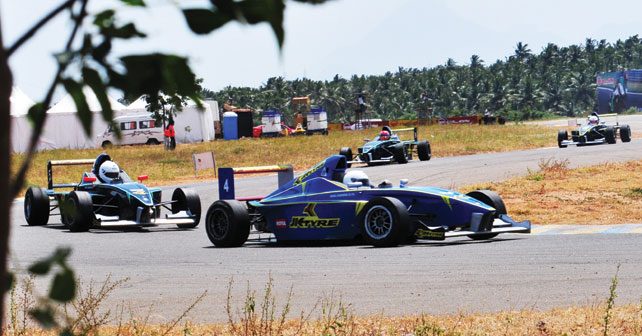The opening round of the JK Racing Championship offers varying views on the balance between promoting brands and racing drivers and providing a means to learn the realities of racing.
Between the two tyre manufacturers who have consistently been the biggest supporters of motorsport in India, JK Tyre is the one that points to its racing championship, now in its 18th year to show that it is the one that finds and promotes racing talent in the country.
It is a role they play with a motorsport ladder that consists of the National Karting Championship, LGB Formula 4 and the JK Racing India Series (former Formula BMW Asia machinery).
Partnering them is Volkswagen whose involvement was unequivacolly said to be anything but an attempt to build and promote motorsport in India, in the words of their former global motorsport head Kris Nissen back in 2008.
While you hear something far different from Volkswagen Motorsport India’s top man Sirish Vissa these days, it is clear that the manufacturer is primarily involved in circuit racing to promote whatever product it chooses to promote. It is a situation that will not change unless rival car manufacturers in India agree to throw their hat into the ring of competition and compete – either as factory teams or through customer programs – in the Indian Touring Car Championship. Until that happens, though, a centrally controlled one-make series like the Vento Cup is primarily a brand promotion exercise for Volkswagen.
Although there is an obvious benefit to the one-make structure; the best driver and not the best car or best driver-car combination wins the title.
Outside of a manufacturer owned one-make series though it can be said that the ideal set up for finding racing talent is one where many teams operate independently to scout and hire drivers who then advance or fall by the wayside depending on their talent, access to resources and will.
WORK IN PROGRESS
There is one series in JK Tyre’s racing slate that does follow this model, much like the way it was done in the erstwhile Formula Rolon albeit on a far smaller scale.
The LGB Formula 4 car is touted as the first step to single seaters after karting, although by the admission of some directly involved in it, it is far from what drivers should be exposed to. Jehan Daruvala and Arjun Maini, two of India’s latest single seat racers, definitely didn’t feel the need to be involved with the series after karting. Although theirs is more a case of talent being mated to having the means to afford top of the line racing and training.
CREATING A STEP
The series is an attempt to create an Indian equivalent to Formula Ford (which has now given way to MSA Formula). In other words, a low-cost, entry level single seat series where drivers learn racecraft and a feel for the mechanics of a single seater before being exposed to aerodynamics. Changes to the Formula 4 car are imminent for next year but there would still be a lot left to get to the ultimate aim of a car that is as close to an FB02 car as possible without using wings but which would remain affordable for homegrown teams to run.
For the near future, however, the most we can hope to see is a far less ungainly looking car, albeit with the same engine and tyres it runs right now. Fingers crossed.























Write your Comment